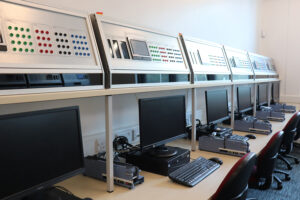Since its inception in 2013, the Graphene Flagship has focused on technological innovation and bringing new graphene-enabled solutions to the market. To this end, it has pioneered the creation of several spin-off companies in industries ranging from energy and materials discovery to biotech and optoelectronics. 
The newest member of this family is Qurv Technologies, launched from Graphene Flagship partner ICFO in Barcelona, Spain and established in 2020 by Antonios Oikonomou, Stijn Goossens, Gerasimos Konstantatos and Frank Koppens.
Qurv was founded to develop graphene-enabled wide-spectrum image sensor technologies for next-generation computer vision applications, bringing unprecedented intelligence to products and services.
Combining the unique electronic properties of graphene with suitable quantum nanoparticles as light sensitisers allows for efficient detection of a broad range of wavelengths – from ultraviolet to infrared light – all concentrated into one simple device. Importantly, the production and transfer process of graphene leverages existing scalable Complementary Metal Oxide Semiconductor (CMOS) manufacturing processes.
Furthermore, this graphene-based sensor replaces traditional costly alternatives based on indium gallium arsenide, paving the way to SWIR imagers up to 1000 times cheaper. This could significantly expand their market.
Graphene-based wide-spectrum sensors will give machines the gift of sight and boost their decision-making capabilities. Computer vision applications are useful in a variety of fields, from autonomous cars – capable of detecting obstacles around them – to intelligent machinery such as service and industrial robots. Qurv has created a ‘plug-and-play’ manufacturing approach, making it more widely compatible and accessible than current alternatives.
Qurv recently joined the Graphene Flagship ecosystem as a Partner and Industrial Advisor of the 2D-EPL Board while undertaking the challenge of leading our Spearhead Project AUTOVISION. This project will produce image sensors based on graphene and quantum-dots, and make them ready for evaluation by the automotive industry. The project still has two more years ahead, during which researchers and innovators within partner institutions will further develop the technology towards industrialisation.
Antonios Oikonomou, co-founder and CEO of Qurv, says: “We are thrilled to announce this new spin-off that aims to fill a significant, ever expanding gap in the imaging market. The capabilities of these sensors are common in defence and aerospace applications, but are inaccessible to most people. We strongly believe that, thanks to our unique combination of advanced quantum materials, we can reduce the cost of SWIR sensors and bring them down to earth, enabling industry uptake. Imaging applications are moving from ‘pretty pictures’ to sensing, and wide-spectrum brings numerous advantages in both performance and function.”
Frank Koppens, co-founder of Qurv and research group leader at Graphene Flagship partner ICFO, adds: “This new company builds upon years of research and development within ICFO and the Graphene Flagship. We are convinced it will become a commercial success, proven by the awards and investments we have already received. We aim to further expand our network within the project, and look forward to the applications and outcomes from AUTOVISION, which will bolster the wider adoption of autonomous driving technologies.”
Kari Hjelt, Head of Innovation at the Graphene Flagship, says: “We have supported spin-offs since the very beginning, and it is fantastic to see new members joining our family of innovators. Qurv’s technology demonstrates that graphene offers cheap, sustainable and environmentally friendly solutions for real industry demands. In addition, this highlights Europe’s advantageous position in the field of graphene and layered materials, facilitated and accelerated by the Graphene Flagship’s multidisciplinary, collaborative ecosystem.”
 Instrumentation Monthly Test | Measurement | Control
Instrumentation Monthly Test | Measurement | Control










